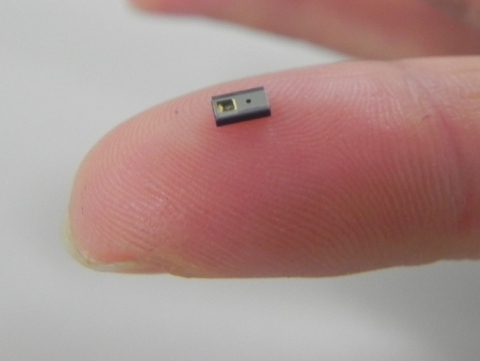KYOTO, Japan--(BUSINESS WIRE)--Kyocera Corporation (NYSE:KYO)(TOKYO:6971) announced that it has developed one of the smallest known optical blood-flow sensors, which measures the volume of blood flow in subcutaneous tissue. With the sensor, Kyocera is researching a variety of mobile health (mHealth) applications such as monitoring stress levels or preventing dehydration, heatstroke and altitude sickness by studying trends or changes in blood-flow volume as alerts for these conditions and developing algorithms for detection.
Leveraging Kyocera’s expertise in miniaturization, the sensor — only 1mm high, 1.6mm long and 3.2mm wide — is designed for use in small devices such as mobile phones and wearable devices. The company will offer sensor module samples starting April 2017, and aims to commercialize the technology as a device by March 2018.
Potential mHealth Applications in Research & Development
- Blood-flow sensing earbuds: Check stress levels or orthostatic hypotension while music plays by analyzing blood flow
- Wearable device for heatstroke prevention: Help prevent dehydration or heatstroke by detecting changes in blood flow
- Wearable device for mountain climbers: Help avoid dehydration or altitude sickness by monitoring blood flow and sending notifications to rehydrate when there are potential risks
Development Background
The wearable device market has expanded substantially in recent years, focused primarily on health and fitness. New mHealth applications are being developed for a wide range of healthcare applications including chronic diseases, eldercare and wellness. Global shipments of healthcare wearables are expected to rise from 2.5 million units in 2016 to 97.6 million units in 2021*1.
Kyocera, which provides a wide range of components for smartphones and wearables, has been developing slimmer, smaller products to support higher functionality in more compact devices. The company developed this sensor as an integrated module, incorporating the laser diode and photodiode into a single ceramic package, based on its established expertise in miniaturization technologies.
Basic Principle and Main Features
Devices equipped with this new sensor will be able to measure blood-flow volume in subcutaneous tissue by placing the device in contact with an ear, finger or forehead*2. When light is reflected on blood within a blood vessel, the frequency of light varies — called a frequency or Doppler shift — according to the blood-flow velocity. The new sensor utilizes the relative shift in frequency (which increases as blood flow accelerates) and the strength of the reflected light (which grows stronger when reflected off a greater volume of red blood cells) to measure blood-flow volume.
Featuring a high signal-to-noise ratio (S/N), small size and low power consumption (output: 0.5mW), the sensor can be easily integrated into a smartphone or wearable device for mHealth applications.
*1 Based on information issued by Tractica LLC in April 2016
*2
The sensor targets capillaries for measurement and cannot be
utilized on all parts of the body; measurement site may depend on
monitoring applications.
To see more images, please visit: http://global.kyocera.com/news/2016/1205_nvid.html
Kyocera Corporation (NYSE:KYO)(TOKYO:6971) (http://global.kyocera.com/), the parent and global headquarters of the Kyocera Group, was founded in 1959 as a producer of fine ceramics (also known as “advanced ceramics”). By combining these engineered materials with metals and integrating them with other technologies, Kyocera has become a leading supplier of electronic components, semiconductor packages, mobile phones, printers, copiers, solar power generating systems, cutting tools and industrial ceramics. During the year ended March 31, 2016, the company’s consolidated net sales totaled 1.48 trillion yen (approx. USD13.1 billion). Kyocera appears on the Thomson Reuters list of the “Top 100 Global Innovators” and is ranked #531 on Forbes magazine’s 2016 “Global 2000” listing of the world’s largest publicly traded companies.




